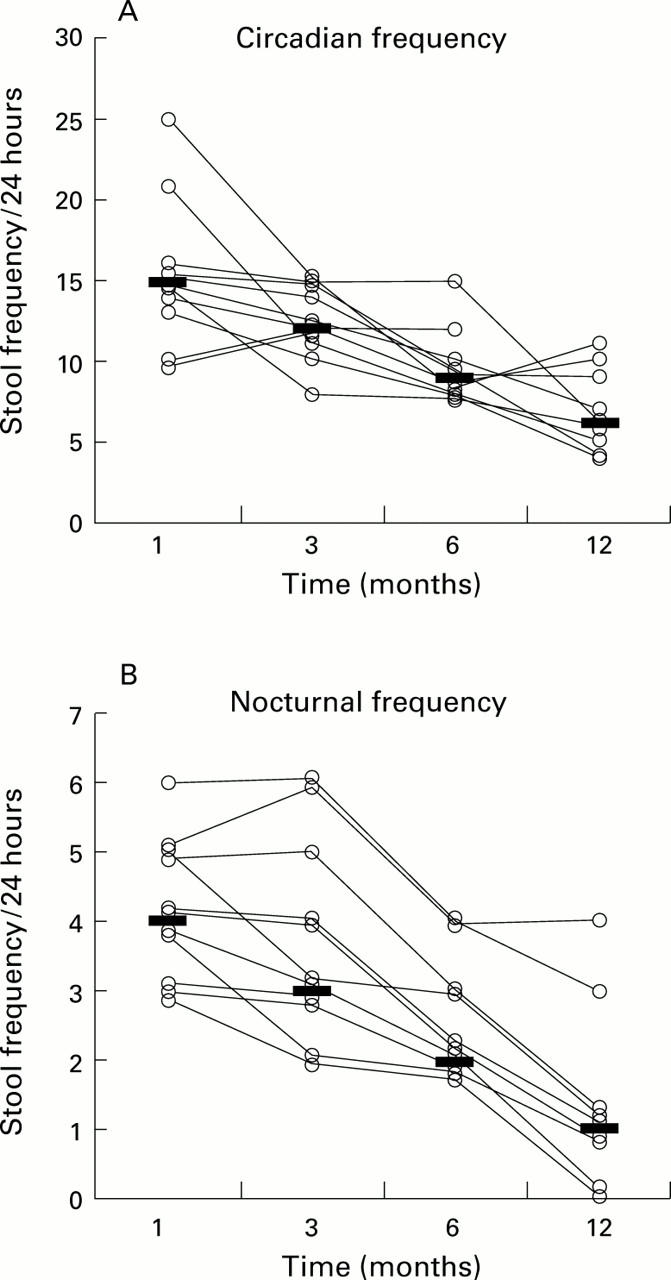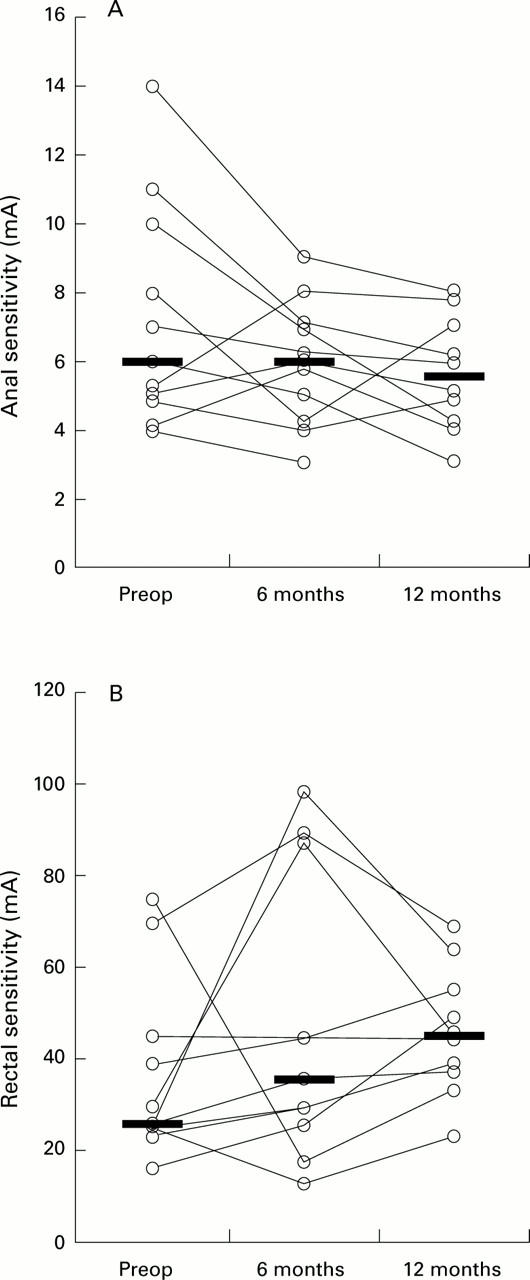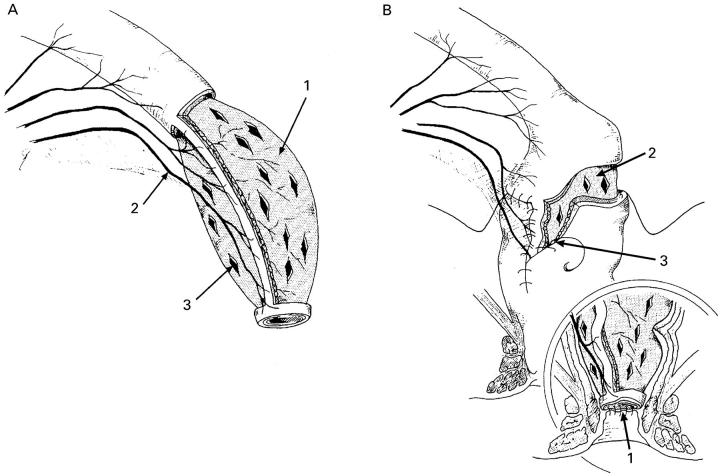Abstract
INTRODUCTION—To reduce pouch related complications after restorative proctocolectomy, an alternative procedure was developed, the ileo neo-rectal anastomosis (INRA). This technique consists of rectal mucosa replacement by ileal mucosa and straight ileorectal anastomosis. Our study provides a detailed description of the functional results after INRA. PATIENTS AND METHODS—Eleven patients underwent an INRA procedure with a temporary ileostomy. Anorectal function tests were performed two months prior to and six and 12 months after closure of the ileostomy and comprised: anal manometry, ultrasound examination, rectal balloon distension, and transmucosal electrical nerve stimulation (TENS). Function was subsequently related to the histopathology of rectal biopsy samples. RESULTS—Median stool frequency decreased from 15/24 hours (10-25) to 6/24 hours (4-11) at one year. All patients reported full continence. Anal sensibility, and resting and squeeze pressures did not change after INRA. Rectal compliance decreased (2.1 (0.7-2.8) v 1.5 (0.4-2.2) and 1.4 (0.8-3.7) ml/mm Hg (p=0.03)) but the maximum tolerated volume increased (70 (50-118) v 96 (39-176) (NS) and 122 (56-185) ml (p=0.03)). Decreasing rectal sensitivity was found: the maximum tolerated pressure increased (14 (8-24) v 22 (8-34) (NS) and 26 (14-40) (p=0.02)) and the rectal threshold for TENS displayed a similar tendency. All patients displayed a low grade chronic inflammatory infiltrate in neorectal biopsy samples before closure of the ileostomy, with no change during follow up. CONCLUSIONS—The technique of INRA provides a safe alternative for restorative surgery. Stool frequency after INRA improves with time and seems to be related to decreasing sensitivity and not to histopathological changes in the neorectum. Furthermore, after the INRA procedure, all patients reported full continence. Keywords: restorative proctocolectomy; anorectal physiology; surgery; neorectum; intestinal mucosa transposition; recto-anal inhibition reflex
Full Text
The Full Text of this article is available as a PDF (180.9 KB).
Figure 1 .
(A) The mucosal sling is created from the distal end of the terminal ileum by removing the seromuscular layer. In order to adapt the sling to the diameter of the rectum and to enable slough to be evacuated from between the rectal cuff and the mucosal sling, multiple longitudinal incisions of 5-10 mm are made in the mucosa. Note that the mucosal vascularisation is preserved because the mesentery is left intact. (B) The ileo neo-rectal anastomosis: anastomosis (3) between the ileum and proximal rectal muscular wall with the ileal mucosal sling (2) plugged on the denuded rectal muscle. The distal end is sutured to the dentate line (1). The central vascular pedicle is shown, as well as the mucosal fenestrations for drainage and increased luminal diameter.
Figure 2 .

(A) Total stool frequency over 24 hours for each patient. The number of stools per 24 hours decreased significantly during follow up (Friedman test, p<0.0001). (B) Stool frequency at night for each patient. Nocturnal stool frequency decreased significantly during follow up (Friedman test, p<0.0001).
Figure 3 .

(A) Anal electrosensitivity thresholds for each patient before and after ileo neo-rectal anastomosis (INRA). Bars indicate median levels. (B) Rectal electrosensitivity thresholds of each patient before and after INRA. Bars indicate median levels.
Selected References
These references are in PubMed. This may not be the complete list of references from this article.
- Becker J. M., LaMorte W., St Marie G., Ferzoco S. Extent of smooth muscle resection during mucosectomy and ileal pouch-anal anastomosis affects anorectal physiology and functional outcome. Dis Colon Rectum. 1997 Jun;40(6):653–660. doi: 10.1007/BF02140893. [DOI] [PubMed] [Google Scholar]
- Becker J. M., McGrath K. M., Meagher M. P., Parodi J. E., Dunnegan D. A., Soper N. J. Late functional adaptation after colectomy, mucosal proctectomy, and ileal pouch-anal anastomosis. Surgery. 1991 Oct;110(4):718–725. [PubMed] [Google Scholar]
- Bernstein C. N., Rollandelli R., Niazi N., Robert M., Hirsh T., Munakata J., Mayer E. A. Characterization of afferent mechanisms in ileoanal pouches. Am J Gastroenterol. 1997 Jan;92(1):103–108. [PubMed] [Google Scholar]
- Broens P. M., Penninckx F. M., Lestár B., Kerremans R. P. The trigger for rectal filling sensation. Int J Colorectal Dis. 1994 Apr;9(1):1–4. doi: 10.1007/BF00304291. [DOI] [PubMed] [Google Scholar]
- Church J. M., Saad R., Schroeder T., Fazio V. W., Lavery I. C., Oakley J. R., Milsom J. W., Tuckson W. Predicting the functional result of anastomoses to the anus: the paradox of preoperative anal resting pressure. Dis Colon Rectum. 1993 Oct;36(10):895–900. doi: 10.1007/BF02050622. [DOI] [PubMed] [Google Scholar]
- Cohen Z., McLeod R. S., Stephen W., Stern H. S., O'Connor B., Reznick R. Continuing evolution of the pelvic pouch procedure. Ann Surg. 1992 Oct;216(4):506–512. doi: 10.1097/00000658-199210000-00013. [DOI] [PMC free article] [PubMed] [Google Scholar]
- Eu K. W., Lim S. L., Seow-Choen F., Leong A. F., Ho Y. H. Clinical outcome and bowel function following total abdominal colectomy and ileorectal anastomosis in the Oriental population. Dis Colon Rectum. 1998 Feb;41(2):215–218. doi: 10.1007/BF02238251. [DOI] [PubMed] [Google Scholar]
- Farouk R., Duthie G. S., Bartolo D. C. Recovery of the internal anal sphincter and continence after restorative proctocolectomy. Br J Surg. 1994 Jul;81(7):1065–1068. doi: 10.1002/bjs.1800810748. [DOI] [PubMed] [Google Scholar]
- Fazio V. W., Ziv Y., Church J. M., Oakley J. R., Lavery I. C., Milsom J. W., Schroeder T. K. Ileal pouch-anal anastomoses complications and function in 1005 patients. Ann Surg. 1995 Aug;222(2):120–127. doi: 10.1097/00000658-199508000-00003. [DOI] [PMC free article] [PubMed] [Google Scholar]
- Felt-Bersma R. J., Gort G., Meuwissen S. G. Normal values in anal manometry and rectal sensation: a problem of range. Hepatogastroenterology. 1991 Oct;38(5):444–449. [PubMed] [Google Scholar]
- Felt-Bersma R. J., Poen A. C., Cuesta M. A., Meuwissen S. G. Anal sensitivity test: what does it measure and do we need it? Cause or derivative of anorectal complaints. Dis Colon Rectum. 1997 Jul;40(7):811–816. doi: 10.1007/BF02055438. [DOI] [PubMed] [Google Scholar]
- Hallgren T., Fasth S., Delbro D., Nordgren S., Oresland T., Hultén L. Possible role of the autonomic nervous system in sphincter impairment after restorative proctocolectomy. Br J Surg. 1993 May;80(5):631–635. doi: 10.1002/bjs.1800800530. [DOI] [PubMed] [Google Scholar]
- Harms B. A., Andersen A. B., Starling J. R. The W ileal reservoir: long-term assessment after proctocolectomy for ulcerative colitis and familial polyposis. Surgery. 1992 Oct;112(4):638–648. [PubMed] [Google Scholar]
- Ho Y. H., Goh H. S. Unilateral anal electrosensation. Modified technique to improve quantification of anal sensory loss. Dis Colon Rectum. 1995 Mar;38(3):239–244. doi: 10.1007/BF02055594. [DOI] [PubMed] [Google Scholar]
- Holdsworth P. J., Johnston D. Anal sensation after restorative proctocolectomy for ulcerative colitis. Br J Surg. 1988 Oct;75(10):993–996. doi: 10.1002/bjs.1800751016. [DOI] [PubMed] [Google Scholar]
- Holdsworth P. J., Sagar P. M., Lewis W. G., Williamson M., Johnston D. Internal anal sphincter activity after restorative proctocolectomy for ulcerative colitis: a study using continuous ambulatory manometry. Dis Colon Rectum. 1994 Jan;37(1):32–36. doi: 10.1007/BF02047211. [DOI] [PubMed] [Google Scholar]
- Horgan A. F., Molloy R. G., Coulter J., Sheehan M., Kirwan W. O. Nerve regeneration across colorectal anastomoses after low anterior resection in a canine model. Int J Colorectal Dis. 1993 Sep;8(3):167–169. doi: 10.1007/BF00341192. [DOI] [PubMed] [Google Scholar]
- Kamm M. A., Lennard-Jones J. E. Rectal mucosal electrosensory testing--evidence for a rectal sensory neuropathy in idiopathic constipation. Dis Colon Rectum. 1990 May;33(5):419–423. doi: 10.1007/BF02156270. [DOI] [PubMed] [Google Scholar]
- Lewis W. G., Miller A. S., Williamson M. E., Sagar P. M., Holdsworth P. J., Axon A. T., Johnston D. The perfect pelvic pouch--what makes the difference? Gut. 1995 Oct;37(4):552–556. doi: 10.1136/gut.37.4.552. [DOI] [PMC free article] [PubMed] [Google Scholar]
- Lewis W. G., Williamson M. E., Miller A. S., Sagar P. M., Holdsworth P. J., Johnston D. Preservation of complete anal sphincteric proprioception in restorative proctocolectomy: the inhibitory reflex and fine control of continence need not be impaired. Gut. 1995 Jun;36(6):902–906. doi: 10.1136/gut.36.6.902. [DOI] [PMC free article] [PubMed] [Google Scholar]
- Loening-Baucke V., Metcalf A. M., Shirazi S. Anorectal manometry in active and quiescent ulcerative colitis. Am J Gastroenterol. 1989 Aug;84(8):892–897. [PubMed] [Google Scholar]
- Lubowski D. Z., Nicholls R. J., Swash M., Jordan M. J. Neural control of internal anal sphincter function. Br J Surg. 1987 Aug;74(8):668–670. doi: 10.1002/bjs.1800740804. [DOI] [PubMed] [Google Scholar]
- Marcello P. W., Barrett R. C., Coller J. A., Schoetz D. J., Jr, Roberts P. L., Murray J. J., Rusin L. C. Fatigue rate index as a new measurement of external sphincter function. Dis Colon Rectum. 1998 Mar;41(3):336–343. doi: 10.1007/BF02237488. [DOI] [PubMed] [Google Scholar]
- Marcello P. W., Roberts P. L., Schoetz D. J., Jr, Coller J. A., Murray J. J., Veidenheimer M. C. Long-term results of the ileoanal pouch procedure. Arch Surg. 1993 May;128(5):500–504. doi: 10.1001/archsurg.1993.01420170030003. [DOI] [PubMed] [Google Scholar]
- Mayer E. A., Gebhart G. F. Basic and clinical aspects of visceral hyperalgesia. Gastroenterology. 1994 Jul;107(1):271–293. doi: 10.1016/0016-5085(94)90086-8. [DOI] [PubMed] [Google Scholar]
- McIntyre P. B., Pemberton J. H., Beart R. W., Jr, Devine R. M., Nivatvongs S. Double-stapled vs. handsewn ileal pouch-anal anastomosis in patients with chronic ulcerative colitis. Dis Colon Rectum. 1994 May;37(5):430–433. doi: 10.1007/BF02076186. [DOI] [PubMed] [Google Scholar]
- McIntyre P. B., Pemberton J. H., Wolff B. G., Beart R. W., Dozois R. R. Comparing functional results one year and ten years after ileal pouch-anal anastomosis for chronic ulcerative colitis. Dis Colon Rectum. 1994 Apr;37(4):303–307. doi: 10.1007/BF02053588. [DOI] [PubMed] [Google Scholar]
- Meagher A. P., Kennedy M. L., Lubowski D. Z. Rectal mucosal electrosensitivity - what is being tested? Int J Colorectal Dis. 1996;11(1):29–33. doi: 10.1007/BF00418852. [DOI] [PubMed] [Google Scholar]
- Miller R., Bartolo D. C., Cervero F., Mortensen N. J. Anorectal sampling: a comparison of normal and incontinent patients. Br J Surg. 1988 Jan;75(1):44–47. doi: 10.1002/bjs.1800750116. [DOI] [PubMed] [Google Scholar]
- Morgado P. J., Jr, Wexner S. D., James K., Nogueras J. J., Jagelman D. G. Ileal pouch-anal anastomosis: is preoperative anal manometry predictive of postoperative functional outcome? Dis Colon Rectum. 1994 Mar;37(3):224–228. doi: 10.1007/BF02048159. [DOI] [PubMed] [Google Scholar]
- Nyam D. C., Brillant P. T., Dozois R. R., Kelly K. A., Pemberton J. H., Wolff B. G. Ileal pouch-anal canal anastomosis for familial adenomatous polyposis: early and late results. Ann Surg. 1997 Oct;226(4):514–521. doi: 10.1097/00000658-199710000-00012. [DOI] [PMC free article] [PubMed] [Google Scholar]
- O'Connell P. R., Pemberton J. H., Brown M. L., Kelly K. A. Determinants of stool frequency after ileal pouch-anal anastomosis. Am J Surg. 1987 Feb;153(2):157–164. doi: 10.1016/0002-9610(87)90807-5. [DOI] [PubMed] [Google Scholar]
- O'Connell P. R., Pemberton J. H., Kelly K. A. Motor function of the ileal J pouch and its relation to clinical outcome after ileal pouch-anal anastomosis. World J Surg. 1987 Dec;11(6):735–741. doi: 10.1007/BF01656596. [DOI] [PubMed] [Google Scholar]
- Ottinger L. W. Frequency of bowel movements after colectomy with ileorectal anastomosis. Arch Surg. 1978 Sep;113(9):1048–1049. doi: 10.1001/archsurg.1978.01370210030003. [DOI] [PubMed] [Google Scholar]
- Pemberton J. H., Kelly K. A., Beart R. W., Jr, Dozois R. R., Wolff B. G., Ilstrup D. M. Ileal pouch-anal anastomosis for chronic ulcerative colitis. Long-term results. Ann Surg. 1987 Oct;206(4):504–513. doi: 10.1097/00000658-198710000-00011. [DOI] [PMC free article] [PubMed] [Google Scholar]
- Penna C., Daude F., Parc R., Tiret E., Frileux P., Hannoun L., Nordlinger B., Levy E. Previous subtotal colectomy with ileostomy and sigmoidostomy improves the morbidity and early functional results after ileal pouch-anal anastomosis in ulcerative colitis. Dis Colon Rectum. 1993 Apr;36(4):343–348. doi: 10.1007/BF02053936. [DOI] [PubMed] [Google Scholar]
- Rabau M. Y., Percy J. P., Parks A. G. Ileal pelvic reservoir: a correlation between motor patterns and clinical behaviour. Br J Surg. 1982 Jul;69(7):391–395. doi: 10.1002/bjs.1800690712. [DOI] [PubMed] [Google Scholar]
- Rao S. S., Read N. W., Brown C., Bruce C., Holdsworth C. D. Studies on the mechanism of bowel disturbance in ulcerative colitis. Gastroenterology. 1987 Nov;93(5):934–940. doi: 10.1016/0016-5085(87)90554-3. [DOI] [PubMed] [Google Scholar]
- Rao S. S., Read N. W., Davison P. A., Bannister J. J., Holdsworth C. D. Anorectal sensitivity and responses to rectal distention in patients with ulcerative colitis. Gastroenterology. 1987 Dec;93(6):1270–1275. doi: 10.1016/0016-5085(87)90255-1. [DOI] [PubMed] [Google Scholar]
- Roe A. M., Bartolo D. C., Mortensen N. J. New method for assessment of anal sensation in various anorectal disorders. Br J Surg. 1986 Apr;73(4):310–312. doi: 10.1002/bjs.1800730421. [DOI] [PubMed] [Google Scholar]
- Sagar P. M., Holdsworth P. J., Johnston D. Correlation between laboratory findings and clinical outcome after restorative proctocolectomy: serial studies in 20 patients with end-to-end pouch-anal anastomosis. Br J Surg. 1991 Jan;78(1):67–70. doi: 10.1002/bjs.1800780121. [DOI] [PubMed] [Google Scholar]
- Silvis R., van Eekelen J. W., Delemarre J. B., Gooszen H. G. Endosonography of the anal sphincter after ileal pouch-anal anastomosis. Relation with anal manometry and fecal continence. Dis Colon Rectum. 1995 Apr;38(4):383–388. doi: 10.1007/BF02054226. [DOI] [PubMed] [Google Scholar]
- Speakman C. T., Kamm M. A., Swash M. Rectal sensory evoked potentials: an assessment of their clinical value. Int J Colorectal Dis. 1993 Mar;8(1):23–28. doi: 10.1007/BF00341272. [DOI] [PubMed] [Google Scholar]
- Sugerman H. J., Newsome H. H. Stapled ileoanal anastomosis without a temporary ileostomy. Am J Surg. 1994 Jan;167(1):58–66. doi: 10.1016/0002-9610(94)90054-x. [DOI] [PubMed] [Google Scholar]
- Sun W. M., Read N. W., Miner P. B. Relation between rectal sensation and anal function in normal subjects and patients with faecal incontinence. Gut. 1990 Sep;31(9):1056–1061. doi: 10.1136/gut.31.9.1056. [DOI] [PMC free article] [PubMed] [Google Scholar]
- Wexner S. D., Wong W. D., Rothenberger D. A., Goldberg S. M. The ileoanal reservoir. Am J Surg. 1990 Jan;159(1):178–185. doi: 10.1016/s0002-9610(05)80625-7. [DOI] [PubMed] [Google Scholar]
- Whitehead W. E., Delvaux M. Standardization of barostat procedures for testing smooth muscle tone and sensory thresholds in the gastrointestinal tract. The Working Team of Glaxo-Wellcome Research, UK. Dig Dis Sci. 1997 Feb;42(2):223–241. doi: 10.1023/a:1018885028501. [DOI] [PubMed] [Google Scholar]
- Williams N. S., Marzouk D. E., Hallan R. I., Waldron D. J. Function after ileal pouch and stapled pouch-anal anastomosis for ulcerative colitis. Br J Surg. 1989 Nov;76(11):1168–1171. doi: 10.1002/bjs.1800761119. [DOI] [PubMed] [Google Scholar]
- de Silva H. J., de Angelis C. P., Soper N., Kettlewell M. G., Mortensen N. J., Jewell D. P. Clinical and functional outcome after restorative proctocolectomy. Br J Surg. 1991 Sep;78(9):1039–1044. doi: 10.1002/bjs.1800780905. [DOI] [PubMed] [Google Scholar]
- van Duijvendijk P., Slors J. F., Taat C. W., Oosterveld P., Vasen H. F. Functional outcome after colectomy and ileorectal anastomosis compared with proctocolectomy and ileal pouch-anal anastomosis in familial adenomatous polyposis. Ann Surg. 1999 Nov;230(5):648–654. doi: 10.1097/00000658-199911000-00006. [DOI] [PMC free article] [PubMed] [Google Scholar]
- van Laarhoven C. J., Andriesse G. I., Schipper M. E., Akkermans L. M., van Vroonhoven T. J., Gooszen H. G. Ileoneorectal anastomosis: early clinical results of a restorative procedure for ulcerative colitis and familial adenomatous polyposis without formation of an ileoanal pouch. Ann Surg. 1999 Dec;230(6):750–758. doi: 10.1097/00000658-199912000-00003. [DOI] [PMC free article] [PubMed] [Google Scholar]



